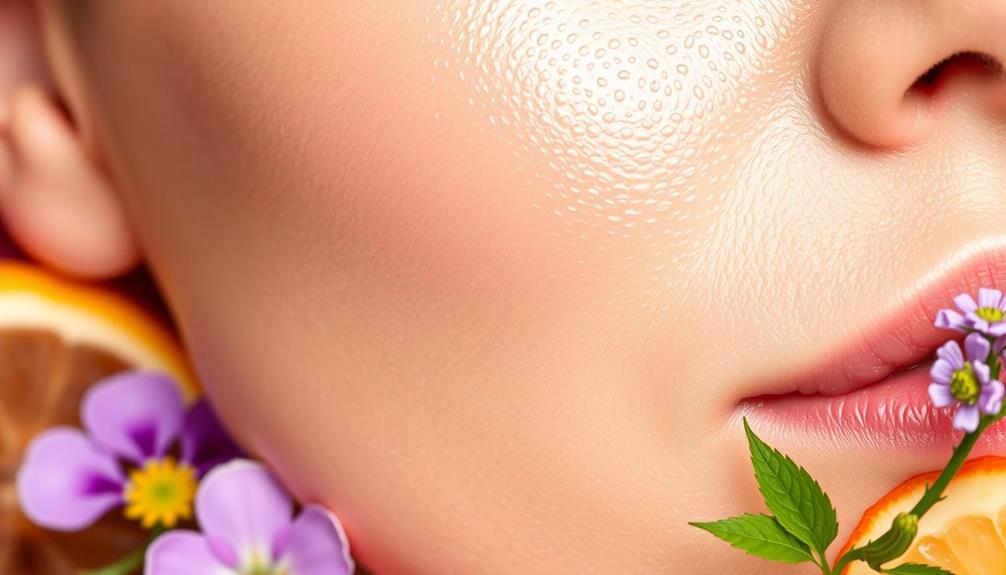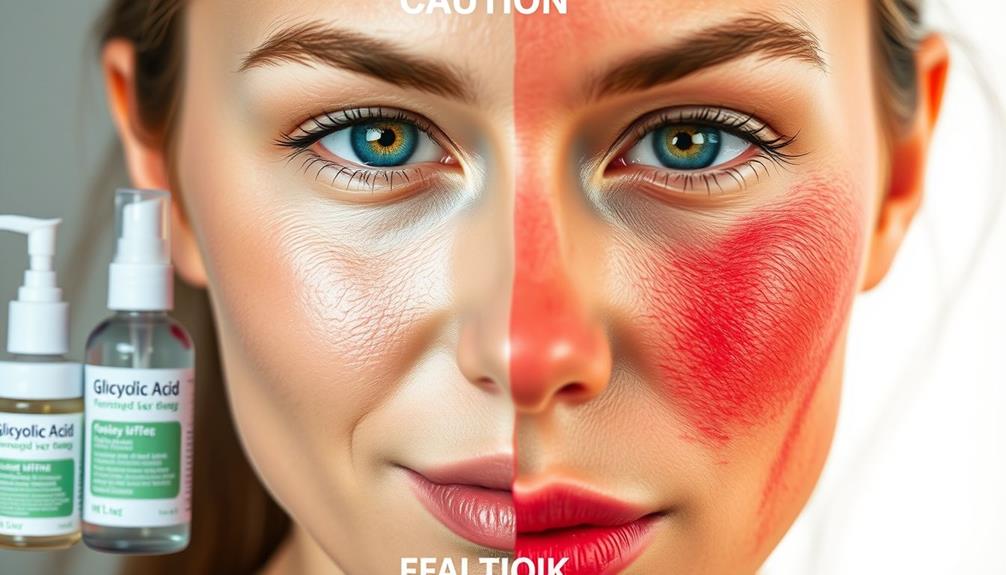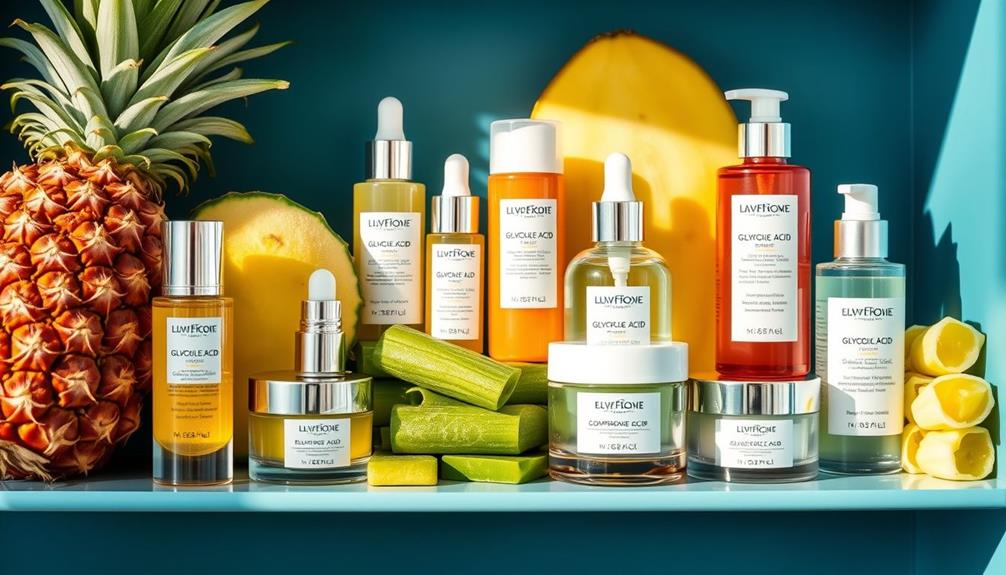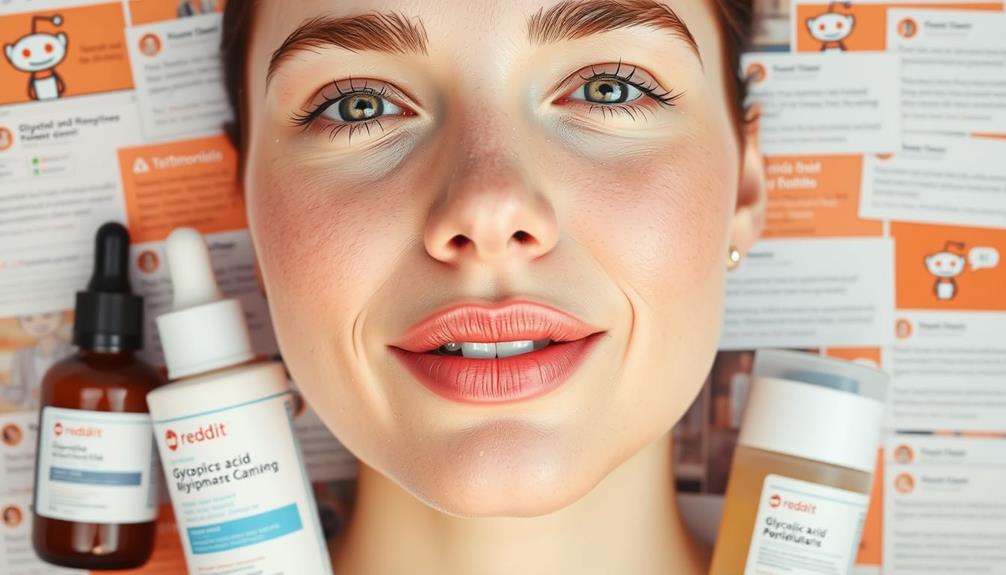Glycolic acid is a potent alpha hydroxy acid that transforms your skin by exfoliating and promoting cell turnover. It unclogs pores, helping to prevent acne, while also fading dark spots and fine lines. With regular use, it hydrates and brightens your complexion, revealing a fresher appearance. You'll notice improved skin texture and clarity as it stimulates collagen production. Just remember to start with lower concentrations to gauge your skin's reaction and always use sunscreen, as glycolic acid can increase sun sensitivity. If you're curious to learn more about how to incorporate it effectively into your routine, keep exploring.
Key Takeaways
- Glycolic acid is an effective exfoliant that promotes cell turnover, revealing fresher skin and improving texture.
- It helps treat acne by unclogging pores, controlling oil, and reducing post-acne hyperpigmentation.
- The acid boosts collagen production, reducing fine lines and enhancing skin elasticity for a more youthful appearance.
- Regular use of glycolic acid brightens skin and helps achieve a more even skin tone by fading dark spots.
What Is Glycolic Acid?

Glycolic acid is an alpha hydroxy acid (AHA) derived from sugar cane that's celebrated for its powerful exfoliating abilities and deep skin penetration.
This small molecular size allows it to effectively dissolve the bonds between dead skin cells, promoting accelerated cell turnover. As a result, you'll reveal fresher, brighter skin underneath, making glycolic acid a popular choice for addressing various skin concerns.
Additionally, incorporating natural elements like essential oils can complement your skincare routine, providing therapeutic benefits that enhance your overall skin health.
Whether you're dealing with acne, fine lines, or hyperpigmentation, glycolic acid can help stimulate collagen production and enhance your skin's overall texture.
It's versatile and suitable for all skin types, though it's important to introduce it gradually to avoid irritation.
You'll find glycolic acid in a range of skincare products, including cleansers, toners, and chemical peels, often recommended for nighttime use due to increased sun sensitivity.
How Glycolic Acid Works

Understanding how glycolic acid works reveals its effectiveness in transforming your skin through deep exfoliation and improved hydration.
As an alpha hydroxy acid (AHA) with a small molecular structure, glycolic acid penetrates deeply to exfoliate skin by dissolving the bonds between dead skin cells. This process promotes their shedding and accelerates cell turnover, revealing fresher, more radiant skin beneath.
Regular use of glycolic acid not only helps to exfoliate but also stimulates collagen production, enhancing your skin's firmness and elasticity. This can reduce the appearance of fine lines and wrinkles, contributing to a more youthful look.
Additionally, glycolic acid provides chemical exfoliation, which helps unclog pores, preventing acne formation and improving overall skin texture and clarity.
In addition to its exfoliating properties, glycolic acid functions as a humectant, drawing moisture to your skin. This action aids in enhancing hydration levels, ensuring your skin maintains a healthy barrier.
Furthermore, using glycolic acid alongside essential oils, such as lavender oil known for its soothing properties, can further enhance your skincare routine.
Benefits for Acne Treatment

When it comes to treating acne, glycolic acid offers several key benefits that can make a real difference for your skin.
It helps with exfoliation and cell renewal, which is essential for maintaining healthy skin and can be complemented by a holistic lifestyle approach that addresses multiple factors influencing skin health.
Additionally, it controls excess oil and reduces dark spots left by past breakouts.
Exfoliation and Cell Renewal
Exfoliating with glycolic acid effectively clears away dead skin cells, helping to prevent acne breakouts and promote a clearer complexion.
As an alpha hydroxy acid (AHA), glycolic acid boosts cell turnover, which is vital for maintaining healthy skin. By speeding up the shedding of dead skin cells, it helps to unclog pores that can otherwise become clogged with sebum and debris, leading to acne formation.
Additionally, it's essential to acknowledge that maintaining a healthy diet and regular vet check-ups are vital for overall skin health, much like how regular vet check-ups are fundamental for a cat's well-being.
Regular use of glycolic acid not only reduces acne lesions but also enhances the effectiveness of other acne treatments. Clinical studies show that even a 5% concentration can markedly improve your skin's condition.
Additionally, glycolic acid plays a role in fading post-acne hyperpigmentation, contributing to a more even skin tone.
You'll also benefit from improved skin texture, as glycolic acid promotes smoother and more radiant skin. Its antibacterial properties further reduce the presence of acne-causing bacteria, making it an excellent choice for anyone struggling with breakouts.
Incorporating glycolic acid into your skincare routine can be a powerful step towards achieving clearer, healthier skin.
Oil Control Mechanism
How can glycolic acid help manage oil production and reduce acne breakouts? Glycolic acid is a powerful ally in your skincare routine, especially for controlling oil. By exfoliating the outer layer of dead skin cells, it helps prevent clogged pores that often lead to acne breakouts. Its humectant properties attract moisture to your skin, balancing oil levels without triggering excess sebum production.
Here's a quick comparison of glycolic acid's benefits for oil control:
| Feature | Benefit |
|---|---|
| Exfoliating | Removes dead skin cells |
| Oil Control | Prevents clogged pores |
| Cell Turnover | Reduces accumulation of dead skin |
| Clear Complexion | Minimizes blemishes and enhances clarity |
Regular use of glycolic acid promotes cell turnover, which means your skin can shed dead skin cells and excess oil more efficiently. Clinical studies show that it markedly improves the appearance of acne-prone skin, making it a fantastic choice for anyone struggling with breakouts. Incorporate glycolic acid into your routine, and you'll likely see a clearer complexion in no time!
Dark Spot Reduction
While glycolic acid effectively controls oil and prevents acne breakouts, it also plays a crucial role in reducing dark spots and improving overall skin tone.
This powerful ingredient promotes cell turnover and exfoliates the outer layer of your skin, helping to fade hyperpigmentation linked to acne scars. By incorporating glycolic acid into your skincare routine, you can greatly enhance your skin's appearance.
As an alpha hydroxy acid (AHA), glycolic acid penetrates deeply, breaking down excess melanin production that contributes to dark spots. Its exfoliating properties not only help diminish existing dark spots but also prevent new ones from forming by keeping your pores clear of dead skin cells.
Regular use of glycolic acid can lead to a more even and radiant skin tone, making it an excellent choice for anyone struggling with post-acne pigmentation.
Additionally, it boosts the effectiveness of other acne treatments you might be using, further aiding in the reduction of dark spots associated with previous breakouts.
Effects on Fine Lines

Glycolic acid effectively reduces the appearance of fine lines by boosting collagen production and enhancing skin elasticity. As an alpha hydroxy acid (AHA), it accelerates cell turnover, which helps shed dead skin cells and reveals fresher, smoother skin. This process minimizes the visibility of fine lines, making your skin look more youthful.
Clinical studies have shown that regular use of glycolic acid can lead to a significant reduction in fine lines within just a few weeks. At a concentration of around 5%, glycolic acid has been statistically proven to improve skin texture while delivering anti-aging benefits. By promoting collagen production, it enhances firmness and elasticity, further smoothing out those pesky fine lines.
Moreover, glycolic acid increases moisture retention through elevated hyaluronic acid levels, which plumps fine lines, making them less noticeable over time. Incorporating glycolic acid into your skincare routine can be a game-changer for combating fine lines, giving your skin a rejuvenated appearance.
Role in Skin Brightening

Glycolic acid plays a key role in brightening your skin by promoting exfoliation and cell renewal.
As it helps shed dull, dead skin cells, you'll reveal a fresher, more radiant complexion.
Plus, it can effectively reduce dark spots and hyperpigmentation, giving you a more even skin tone.
Exfoliation and Cell Renewal
Exfoliating with glycolic acid accelerates cell renewal, revealing brighter and more radiant skin. As an alpha-hydroxy acid (AHA), glycolic acid works by breaking down the bonds between dead skin cells, which promotes effective exfoliation.
This process helps remove those dull, lifeless cells from your skin's surface, enhancing overall skin texture. With regular use, glycolic acid speeds up cell turnover, bringing fresh skin cells to the forefront. This can greatly improve skin brightness and clarity, making your complexion look more vibrant.
You'll notice a visible reduction in the appearance of dark spots and an overall improvement in your even skin tone. Moreover, incorporating glycolic acid into your skincare routine can enhance skin smoothness, giving you that coveted soft and supple feel.
Many users see noticeable results after consistent application, proving its effectiveness in transforming dull skin into a more radiant canvas. By prioritizing exfoliation and cell renewal with glycolic acid, you'll not only boost your skin's health but also achieve that luminous look you desire.
Reducing Dark Spots
Reducing dark spots becomes easier with the regular use of glycolic acid, which promotes skin cell turnover and reveals a brighter, more even complexion. This powerful acid works wonders by exfoliating the outer layer of your skin, effectively fading hyperpigmentation like dark spots and melasma. As you incorporate glycolic acid into your routine, you'll notice improved skin brightness and even tone, especially if you struggle with post-inflammatory hyperpigmentation from acne.
Here's a quick overview of how glycolic acid aids in reducing dark spots:
| Action | Benefit | Additional Notes |
|---|---|---|
| Promotes cell turnover | Reveals healthier skin underneath | Fades dark, damaged skin cells |
| Exfoliates skin | Reduces hyperpigmentation | Targets melanin production |
| Enhances brightening agents | Boosts effectiveness of vitamin C | Prepares skin for better absorption |
| Regular use | Noticeable improvement over time | Achieves a more even complexion |
With consistent application, you'll harness the full power of glycolic acid to reduce dark spots and achieve glowing, radiant skin.
Exfoliation and Skin Texture

Using glycolic acid can transform your skin by promoting chemical exfoliation, leading to a smoother and more radiant texture. This powerful alpha hydroxy acid works by breaking down the bonds between dead skin cells, allowing them to be easily sloughed away.
As you incorporate glycolic acid into your routine, you'll notice an acceleration in skin cell turnover, typically revitalizing your skin's surface every 28 days. Regular use considerably reduces the appearance of rough or textured skin, helping to create that coveted smooth skin look.
Glycolic acid toners and serums, especially those with a 5% concentration, have been statistically proven to enhance overall skin texture. By targeting dead skin cells, they prevent clogged pores and promote a clearer complexion.
For best results, consider adding glycolic acid to your evening skincare routine. It supports your skin's natural regeneration process overnight, maintaining a polished skin texture while you sleep.
With consistent use, you'll not only enjoy improved skin texture but also a more radiant and youthful appearance. Embrace the power of glycolic acid and release your skin's full potential!
Risks and Side Effects

While glycolic acid offers many benefits, you should be aware of potential skin irritation and increased sensitivity to the sun.
If you're using it, make sure to apply broad-spectrum sunscreen daily to protect your skin.
Starting with a lower concentration can help minimize adverse reactions as your skin adjusts.
Possible Skin Irritation
Glycolic acid can lead to skin irritation, causing redness, itching, and a burning sensation, especially for those with sensitive skin. If you're new to acid exfoliants, start slowly. Overusing glycolic acid or using products with high concentrations can result in painful chemical burns, leaving your skin peeling and uncomfortable.
It's vital to introduce this acid gradually, particularly if you have darker skin tones, as strong formulations may lead to hyperpigmentation. To minimize the risk of irritation, always conduct a patch test before applying glycolic acid to larger areas. This simple step can help you gauge how your skin reacts, allowing you to adjust usage accordingly.
Remember, even if your skin tolerates glycolic acid well, it's still important to monitor for any signs of irritation. Additionally, while this ingredient can enhance your skin's appearance, it can also increase sun sensitivity. Consequently, applying a broad-spectrum sunscreen with at least SPF 30 is essential to protect your skin from UV damage.
Sun Sensitivity Risks
Incorporating glycolic acid into your skincare routine can markedly heighten your skin's sensitivity to UV rays, increasing the risk of sunburn and damage if you don't take proper precautions.
When using glycolic acid, your skin becomes more reactive to sunlight, making effective skin protection essential. It's recommended you apply glycolic acid products at night, allowing your skin to recover while minimizing sun exposure during the day.
During the day, always apply sunscreen with at least SPF 30, and remember to reapply every two hours when you're outside. This is important because without adequate sunscreen, you're at a greater risk of experiencing skin damage.
Even on cloudy days, UV rays can penetrate through clouds, so don't skip the sunscreen.
Consider wearing protective clothing, such as long sleeves and hats, to further safeguard your sensitive skin.
Best Ways to Use

To get the most out of glycolic acid, start with a low concentration to see how your skin reacts before gradually increasing the strength. Begin with a product that contains around 5% glycolic acid, and once your skin adjusts, you can move up to 10% if needed. Incorporate glycolic acid into your nighttime skincare routine to enhance its exfoliating effects while promoting cell turnover and minimizing skin sensitivity.
Daily use of glycolic acid cleansers or toners is a great way to maintain glowing skin. However, reserve stronger chemical peels for once a week or every two weeks to prevent irritation. Always follow up with moisturizers to keep your skin hydrated and balanced.
Don't forget the sunscreen! Using a broad-spectrum SPF 30 or higher during the day is essential, as glycolic acid can increase your skin's sensitivity to UV rays. Monitor your skin's response closely, adjusting the frequency of application as needed. With these tips, you'll maximize the benefits of glycolic acid while keeping your skin healthy and radiant.
Choosing Glycolic Acid Products

Finding the right glycolic acid products can greatly enhance your skincare routine and help you achieve radiant skin. To make the best choices, consider the following factors:
| Factor | Recommendation |
|---|---|
| Concentration | Up to 10% for home use |
| pH Level | Aim for a pH around 4 |
| Product Type | Choose leave-on products |
| Skin Type | Tailor to your specific needs |
Start with lower concentrations if you have sensitive skin or are new to glycolic acid. Conduct a patch test on a small area before applying the product fully. This step's essential for avoiding adverse reactions. If your skin tolerates it well, you can gradually increase the concentration.
Leave-on products like serums and creams tend to provide better results than wash-off formulations. These products maximize exfoliating efficacy, helping your skin glow. Remember, everyone's skin is unique, so listen to your skin's needs and adjust your approach accordingly. By selecting the right glycolic acid products, you're on your way to achieving that radiant complexion you desire!
Incorporating in Your Routine

When you add glycolic acid to your nighttime skincare routine, it can enhance exfoliation while minimizing sun sensitivity. Start with a low concentration, around 5%, and gradually increase usage as your skin builds tolerance. This approach helps reduce the risk of irritation.
Incorporate glycolic acid as a treatment for your skin, but remember to apply a hydrating moisturizer afterward to maintain your skin's hydration and barrier function. Using glycolic acid at night allows you to maximize its exfoliating benefits while you sleep.
During the day, it's essential to use a broad-spectrum sunscreen (SPF 30+) since glycolic acid can increase your skin's vulnerability to UV damage.
To get the most out of your routine, alternate glycolic acid with other active ingredients like retinol on different nights. This not only enhances efficacy but also minimizes irritation potential.
Monitor your skin's response and adjust the frequency of glycolic acid use as needed. With the right balance, you'll be on your way to smoother, more radiant skin without compromising its health.
Conclusion
Incorporating glycolic acid into your skincare routine can be a game-changer, releasing a brighter, smoother complexion.
Like a gentle breeze sweeping away the dust, it clears away dullness, revealing your skin's natural glow.
Whether you're targeting acne, fine lines, or uneven tone, this powerhouse ingredient offers a multitude of benefits.
Just remember to start slow and choose the right products to maximize its potential.
Your skin will thank you for the boost of radiance!










